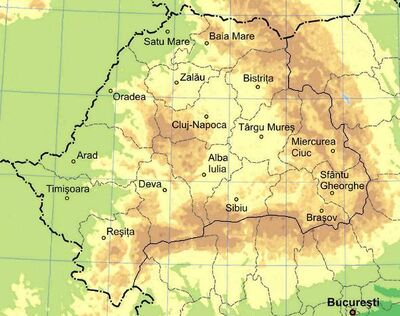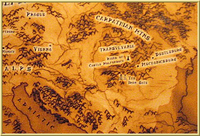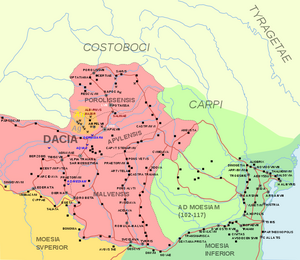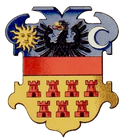m (Added images) |
m (Added a Has-Mad) |
||
| (2 intermediate revisions by 2 users not shown) | |||
| Line 1: | Line 1: | ||
| − | [[File:Physical_map_of_Transylvania.jpg|thumb|right|400px|Our modern Transylvania, with intact mountains]][[File: |
+ | [[File:Physical_map_of_Transylvania.jpg|thumb|right|400px|Our modern Transylvania, with intact mountains]][[File:Wulfenbach Transylvania2.png|thumb|left|200px|From 'The Map']]The '''Transylvania''' of ''Girl Genius'' is not quite the Transylvania which is part of the modern nation of Romania. However, the gross geography and geology, and ethnic makeup are probably similar enough to use general information from one to describe the other. For more about the real-world Transylvania, check out [http://en.wikipedia.org/wiki/Transylvania this article] at Wikipedia, from which the following text is adapted: |
At various times in the past, the region known currently as Transylvania has |
At various times in the past, the region known currently as Transylvania has |
||
| Line 19: | Line 19: | ||
Transylvania is part of a land described in extremes - rich lowlands, dense |
Transylvania is part of a land described in extremes - rich lowlands, dense |
||
forests, inaccessible mountains, and a wealth of fierce four-legged wildlife: bears, wolves, lynx, deer, and wild boar. When the tribe which grew into House Heterodyne settled in, it added fierce two-legged wildlife as well, and has been as productive an area for Sparky tendencies as it has for its many natural resources and proud non-sparky peoples. |
forests, inaccessible mountains, and a wealth of fierce four-legged wildlife: bears, wolves, lynx, deer, and wild boar. When the tribe which grew into House Heterodyne settled in, it added fierce two-legged wildlife as well, and has been as productive an area for Sparky tendencies as it has for its many natural resources and proud non-sparky peoples. |
||
| + | |||
| + | == Theories == |
||
| + | {{Has-Mad}} |
||
[[Category:Geography]] |
[[Category:Geography]] |
||
| − | [[Category:Countries]] |
||
[[Category:Outside World]] |
[[Category:Outside World]] |
||
Revision as of 00:12, 29 April 2013

Our modern Transylvania, with intact mountains

From 'The Map'
The Transylvania of Girl Genius is not quite the Transylvania which is part of the modern nation of Romania. However, the gross geography and geology, and ethnic makeup are probably similar enough to use general information from one to describe the other. For more about the real-world Transylvania, check out this article at Wikipedia, from which the following text is adapted:
At various times in the past, the region known currently as Transylvania has belonged to the Dacians, the Romans, the Huns, the Gepids (an East Germanic Gothic tribe), the Bulgarians, the Ottomans and the Hungarians. Transylvania was first referred to in a Medieval Latin document in 1075 as Ultra silvam, meaning "exceedingly rich in forests, covered with forests"; the spelling was gradually abbreviated to "Tra-silvania" at first, and ultimately changed to "Transylvania" (trans meaning "across, over, beyond"). The Romanian name Ardeal has a more disputed origin - it's theorized it came from everything from the Celtic word Arduenna for "forest", to the Khazar "Ardil-land", or the Hungarian name Erdély, or even an elision from the words aur and deal ("gold" and "hill", respectively; the word "aur" also means "gold" in modern Welsh).
The Transylvanian plateau, 300 to 500 meters (1,000-1,600 feet) high (barring Spark-generated terrain changes), is drained by the Mureş, Someş, Criş, and Olt rivers, as well as other tributaries of the Danube. It is bounded on the west by the range termed the "Western Romanian Carpathians", on the east by the "Inner Eastern Carpathians" and the south by the "Southern Carpathians". Many of these mountains could have been destroyed or greatly altered during the vicious Spark-driven wars ranging over Europa. The Carpathians as a whole extend much farther, but the arc they follow begins and ends at the Danube River. The Mureş River and its valley provides a relatively easy east-west passage from the Inner Carpathians, along the southern edge of the plateau, around the southern bounds of the Apuseni Mountains (part of the Western Roman Carpathians and the estimated location of the Wulfenbach lands) and into Hungary. Other routes onto the plateau would have to detour north around the Apusenis (following the Danube), or over whatever passes may be in the Southern or Eastern Carpathians.

Dacia, during Roman settlement
The oldest extant cities in Transylvania were founded the Dacians and their Roman conquerors. Currently, the land is settled by four primary groups: The Vlachs (Români); the Magyars (Magyarok) and Székely, who identify as Hungarian; and the Saxons, decendants of German settlers hired as border mercenaries and specialty workers.
- "Vlachs" (from the same root word that produced "Welsh" and "Wallach", meaning "outsider") descend predominantly from the Romanized Dacians, Thracians and Illyrians, the indigenous populations of the Balkans, and Roman colonists (from various provinces of the Roman Empire). They are not restricted to Transylvania, Moldavia, et al. but include the Romanians, Aromanians, Morlachs, Megleno-Romanians and Istro-Romanians. They were primarily a shepherding people in their early days and thus were spread far across eastern Europe. Their Proto-Romanian developed into languages dominating the whole arc of the Carpathian Mountains, although they remained the peasantry of the land that took their name.
- The Magyars have an ambiguous origin, but seem to be decended from a tribe of Finno-Ugric speakers who first lived around the Ural Mountains and gradually moved south and west over many centuries. While the proto-Magyar settled around the Ob River, they were heavily influenced by Iranian neighbors, and later by Khazar tribes, the Bulgars, and Slavs. Eventually they moved into the Transylvanian plateau and gradually adapted to an agricultural life instead of raiding.
- The Székely have historically claimed descent from Attila's Huns, though the relation between Huns and Magyars is not proven. While this idea remains an important part of Székely tradition and folk culture, the theory has since lost scholarly currency. Theories suggest Avar, Gepid, or Turkic ancestry, and some have dated their presence in the Eastern Carpathians as early as the fifth century. A small number of scholars believe that they are related to Scythians who might have joined the Magyars on their trek westward. Many scholars believe in a two-fold Hungarian migration to Transylvania; the Székely are a Hungarian group that settled during this first migration.

Arms of the Siebenbürgen
- The Saxons migrated to Transylvania in the 12th century at the behest of the then-Hungarian ruler to provide border troops (mercenaries), and help enhance the local economy with skilled miners and other craftsmen. In two major waves over the space of a century, colonists arrived from many German areas to settle around seven fortified towns in particular, especially after the devastation of the Mongol hordes. These towns led to Transylvania also being known in German as Siebenbürgen and Septem Castra in Latin. Historically, they held a privileged social position with the two Hungarian ethnic groups.
Transylvania is part of a land described in extremes - rich lowlands, dense forests, inaccessible mountains, and a wealth of fierce four-legged wildlife: bears, wolves, lynx, deer, and wild boar. When the tribe which grew into House Heterodyne settled in, it added fierce two-legged wildlife as well, and has been as productive an area for Sparky tendencies as it has for its many natural resources and proud non-sparky peoples.
